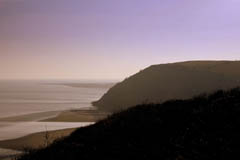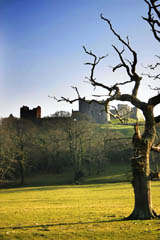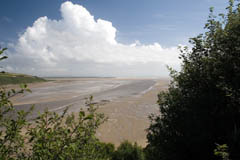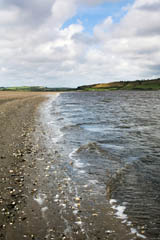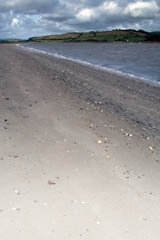Llanstephan (Llan-Stephan) - From 'A Topographical Dictionary of Wales' (1849)
LLANSTEPHAN (LLAN-STEPHAN), a parish, in the Higher division of the hundred of Derllŷs, union and county of Carmarthen, in South Wales, 8 miles (S. S. W.) from Carmarthen; containing 1253 inhabitants. This parish derives its name from the dedication of its church to St. Stephen. It was distinguished at a very early period for a fortress of great strength, erected on the summit of a bold eminence that projects into the bay of Carmarthen, and defending the entrance of the river Towy, which falls into the bay at this place: by whom, or at what precise time, it was founded is unknown. Cadell, Meredydd, and Rhŷs, sons of Grufydd ab Rhŷs, Prince of South Wales, having, in the year 1143, possessed themselves of Carmarthen Castle, were encouraged to appear before that of Llanstephan, the relief of which was attempted by a large body of Anglo-Normans; but success still attending the arms of the Welsh chieftains, these forces were defeated, and the fortress was taken. Meredydd, to whom its custody was entrusted, was here vigorously assailed by the Normans, who soon after laid siege to it. The Welsh commander suffered them to complete their preparations for the attack; the scaling ladders were fixed and manned; but just as the assailants were gaining the battlements, he brought certain engines, which he had contrived for that purpose, to bear upon the enemy, and precipitated them to the ground. The Normans, frustrated in their attempt upon the castle, raised the siege and retired; but after a short time renewing their attempts, they ultimately obtained possession of it. In 1216 it was taken and destroyed by Llewelyn ab Iorwerth; and after being rebuilt, was successfully attacked, in the year 1254, by Llewelyn ab Grufydd.
The parish is situated on the shore of Carmarthen bay, and is bounded on the north-east by the parish of Llangain; on the north-west by the parishes of Llangunnock and Llandilo-Abercowin, and on the west and south by the river Towy and the sea. It comprises by admeasurement 5000 acres, of which 2500 are arable, 2000 pasture, and the rest wood, rocks, and waste. The common lands were inclosed by act of parliament obtained in 1807, under the provisions of which a very considerable portion was allotted to the respective landowners. The scenery is highly pleasing, and in many parts beautifully picturesque; the views over the open bay are interesting and extensive, and the course of the river Towy, with its wooded banks, still further enlivens and diversifies the prospect. There are some seats and handsome residences in the parish, which add greatly to the variety of the scenery. Llanstephan Place, an elegant modern mansion, built upon an estate formerly belonging to the Lloyds, is situated in a richly wooded demesne, with a fine lawn sloping gradually from the front of the house to the margin of the Towy. Laques, the seat of the ancient family of Lloyd, the former proprietors of Llanstephan Place, is a substantial residence, now much neglected, in a very sequestered part of the parish, containing some pleasing rural scenery. Llanstephan Cottage, near the river, is sheltered in the rear by rising grounds covered with young plantations, and commands a beautiful view of the bay; the grounds are tastefully disposed, and open upon the sands, which are peculiarly fine, and in summer afford to the inhabitants an agreeable marine parade. Maesgwynne occupies an elevated site, embracing an extensive view of the hills, and is surrounded with plantations. The appearance of the village is peculiarly interesting; but, from its retired situation, being distant from any great thoroughfare, it is not much frequented by visitors. It unites all the advantages of a maritime situation with the tranquil retirement of an inland village, and has a greater number of opulent families resident in it than any other in the neighbourhood of Carmarthen. An excellent turnpike-road leads from it to Carmarthen; and a ferry across the river Towy communicates with the village of Ferryside, on the opposite shore, in the parish of St. Ishmael's. The parish also contains the village of Llanybree. Limestone is quarried, about 1000 tons of which are burnt every year.
The living, rated as a vicarage in the king's books at �8. 13. 4., is a perpetual curacy, with that of Llangunnock annexed, endowed with �200 private benefaction, �600 royal bounty, and �1500 parliamentary grant; net income, �101, with a glebehouse; patrons and impropriators, Messrs. Morris, bankers, of Carmarthen, and Miss Lloyd. The tithes of the parish have been commuted for a rentcharge of �529; and there is a glebe attached, of twenty-three acres, valued at �17 per annum. The church, dedicated to St. Stephen, is an ancient structure, with a lofty tower, and is about 120 feet in length and 30 in breadth. In the hamlet of Llanybree was formerly a chapel of ease, called in ancient records the Marble Church, and now appropriated on Sunday to a congregation of Independents, and during the week used for a Church day school. There are one or two other places of worship for Independents, and one each for Calvinistic Methodists, Wesleyan Methodists, and Baptists; several day schools, in connexion with the Church; and six Sunday schools, one of which is conducted on Church principles. Some remains yet exist of the ancient castle, consisting chiefly of the shell, which is tolerably entire, especially the principal entrance: from the towers, which are still accessible by means of the old staircase, though greatly dilapidated, may be obtained a fine marine view, embracing a portion of the Glamorganshire and Pembrokeshire coasts. St. Anthony's well, in the parish, was once in very high repute for the supposed miraculous cures effected by the water, under the auspices of its patron saint; but it is now entirely neglected. |



